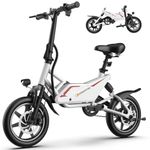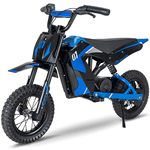1 bestElectric Trikesof December 2025
112M consumers helped this year.
A Guide to Selecting the Best Electric Trikes
Choosing the right electric trike can make a big difference in your comfort, safety, and enjoyment. Electric trikes are three-wheeled vehicles powered by an electric motor, offering extra stability compared to two-wheeled bikes. When shopping for an electric trike, it's important to think about how and where you'll use it—whether for commuting, running errands, or leisurely rides. Understanding the main features will help you find a trike that matches your needs and lifestyle.
Motor Power
Motor power, usually measured in watts (W), determines how much assistance the trike can provide, especially when climbing hills or carrying heavy loads. Lower power motors (around 250W) are suitable for flat terrain and lighter riders, while mid-range motors (350W-500W) offer a balance for moderate hills and average loads. Higher power motors (750W and above) are best for steep hills, heavier riders, or carrying cargo. Think about your typical routes and how much help you want from the motor to choose the right power level.
Battery Capacity
Battery capacity, measured in watt-hours (Wh) or amp-hours (Ah), affects how far you can travel on a single charge. Smaller batteries (under 400Wh) are fine for short trips or occasional use, while mid-sized batteries (400-600Wh) suit regular commuting or longer rides. Large batteries (over 600Wh) are ideal if you plan to ride long distances or want to avoid frequent charging. Consider your average trip length and how often you want to recharge when deciding on battery size.
Range
Range is the estimated distance the trike can travel on one battery charge. This depends on factors like battery size, motor power, rider weight, and terrain. Short-range trikes (up to 20 miles) are good for local errands, medium-range (20-40 miles) for daily commuting, and long-range (over 40 miles) for extended rides or touring. Match the range to your typical riding habits to avoid running out of power mid-trip.
Wheel Size
Wheel size affects ride comfort, stability, and how easily the trike handles bumps. Smaller wheels (16-20 inches) make the trike more compact and easier to store, but may feel bumpier on rough roads. Larger wheels (24-26 inches) provide a smoother ride and better stability, especially on uneven surfaces. Choose wheel size based on your comfort preferences and the types of roads or paths you'll use most often.
Frame Design and Step-Through Height
The frame design, especially the height of the step-through area, determines how easy it is to get on and off the trike. Low step-through frames are ideal for people with limited mobility or those who want extra convenience. Higher frames may offer more rigidity but can be harder to mount. Consider your physical needs and how often you'll be getting on and off the trike to pick the right frame style.
Cargo Capacity
Cargo capacity refers to how much weight and space the trike can handle for carrying groceries, bags, or other items. Some trikes have large rear baskets or platforms, while others offer smaller storage options. If you plan to use the trike for shopping or transporting goods, look for a model with ample cargo space and a higher weight limit. Think about what you’ll typically carry to ensure the trike meets your needs.
Braking System
The braking system is crucial for safety, especially since trikes can be heavier and carry more load than regular bikes. Common types include rim brakes, disc brakes, and drum brakes. Disc brakes generally offer the best stopping power, especially in wet conditions, while rim and drum brakes may require less maintenance. If you’ll be riding in hilly areas or carrying heavy loads, prioritize a trike with strong, reliable brakes.
Seating Comfort
Seating comfort is important for longer rides or if you have back or mobility issues. Some trikes have wide, padded seats with backrests, while others have more basic seating. Adjustable seats and ergonomic designs can make a big difference in comfort. Consider how long you’ll be riding at a time and any personal comfort needs when evaluating seat options.
Best Reviews Guide Newsletter
Get exclusive articles, recommendations, shopping tips, and sales alerts
Sign up for our newsletter to receive weekly recommendations about seasonal and trendy products
Thank you for subscribing!
By submitting your email address you agree to our Terms and Conditions and Privacy Policy


